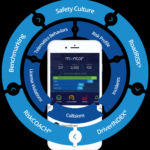Blog
8 Trends Shaping the Future of Driver Risk Management in 2023
Originally published in Fleet Management Weekly 1/5/23

By Ed Dubens, CEO/Founder, eDriving
As a new year emerges, fleet managers are facing more pressure than ever to adapt and modernize their fleet in all ways — from reducing emissions to upgrading vehicles, to optimizing routes, and, most importantly, keeping their drivers and communities in which they work safe.
Are you looking to implement a driver risk management program in 2023? Or upgrade an existing one? If so, keep these 8 trends in mind:
Comprehensive driver risk management – Even if your company already provides safety training, is it part of a comprehensive program that evaluates individual driver risk, incorporates multiple data insights, pinpoints each driver’s unique strengths and weaknesses, and consistently provides high-quality manager coaching and engaging driver training to keep positive behavior changes in place? Driver risk management initiatives are more likely to produce sustainable results with a comprehensive program that identifies risk at the driver and fleet level and provides multi-faceted remediation measures to mitigate them.
- Smartphone telematics – While on-board diagnostics (OBDs) do provide meaningful data on driver behaviors, these devices tend to be somewhat inflexible, as they are tied to the vehicle itself and do not “move” with the driver, so prove more challenging for
 “grey” fleets. Smartphone-based telematics programs, on the other hand, can collect a far broader variety of meaningful driver behavior data, including those determined by research to be most predictive of collisions – acceleration, braking, cornering, speeding, and distraction. When used as part of a comprehensive risk management program, smartphone analytics can provide critical insights into driver weak spots and help evolve fleets from reactive to proactive driver risk management.
“grey” fleets. Smartphone-based telematics programs, on the other hand, can collect a far broader variety of meaningful driver behavior data, including those determined by research to be most predictive of collisions – acceleration, braking, cornering, speeding, and distraction. When used as part of a comprehensive risk management program, smartphone analytics can provide critical insights into driver weak spots and help evolve fleets from reactive to proactive driver risk management. - Less is more – Bite-sized eLearning is IN! Technology has shaped employee’s expectations for how and when they should learn. Microlearning improves retention by delivering information in 3 to 5-minute doses, preventing cognitive overload. Using tools including quizzes, supplementary resources, and follow-up questions to reinforce learning has the potential to increase long-term retention rates to above 90%*. Effective driver training should be interactive, engaging, motivating, and easy to access across desktop and mobile platforms. Also, by utilizing telematics and driver risk profiles to accurately measure driver risk levels, you can identify areas of weakness in need of additional training, and can provide training modules directly to the driver, both routinely, and in response to specific risky behaviors.
- Continuous license monitoring – Moving to continuous license monitoring versus one-time license checks is a must for safety-focused fleets. Annual MVR checks may allow dangerous drivers to remain on the road for up to a year. Collisions are more likely to occur when risky drivers are behind the wheel, and when they do, they could be severe enough to merit a nuclear lawsuit against the fleet operator. The upfront cost of continuous license monitoring helps protect fleets from such potentially catastrophic events, saves fleets considerable costs over time, and proactively protects drivers by more accurately assessing risk in time to provide remediation and support
 Integrated automatic crash detection & emergency response – Automatic crash detection is now available in some smartphone-based driver safety programs, including Mentor by eDriving, allowing employees and contractors in any vehicle to be protected 24/7 should a crash occur while driving for work purposes. And yet, emergency response following a collision is sometimes overlooked or taken for granted, and employers may not always consider the critical role it can play in reducing the severity of injuries sustained and protecting their drivers in their most critical moment of need. Emergency response that includes global coverage and immediate connection with live operators speaking the driver’s language is critical for fleets with drivers around the world. Mentor by eDriving’s automatic crash detection powered by Sfara and Bosch provides live call center support and dispatch of emergency services in over 50+ countries.
Integrated automatic crash detection & emergency response – Automatic crash detection is now available in some smartphone-based driver safety programs, including Mentor by eDriving, allowing employees and contractors in any vehicle to be protected 24/7 should a crash occur while driving for work purposes. And yet, emergency response following a collision is sometimes overlooked or taken for granted, and employers may not always consider the critical role it can play in reducing the severity of injuries sustained and protecting their drivers in their most critical moment of need. Emergency response that includes global coverage and immediate connection with live operators speaking the driver’s language is critical for fleets with drivers around the world. Mentor by eDriving’s automatic crash detection powered by Sfara and Bosch provides live call center support and dispatch of emergency services in over 50+ countries.
- Driver Coaching – Driver performance coaching has been found to be one of the best methods of reinforcing safer, sustained low-risk behaviors and one of the most effective ways to reinforce eLearning in high-risk drivers. Ideally, a driver risk management program should provide tools to assist managers in coaching their drivers, such as step-by-step templates customized for post-collision and ongoing risk mitigation scenarios.
- Eco tracking – Many governments and organizations have set their sights on achieving a zero-emissions carbon footprint, and now real-time emissions tracking can be right at drivers’ fingertips. While traditionally, OBDs were the go-to tool for measuring vehicle emissions, smartphone solutions provide fleet managers with more power than ever to quantify and reduce emissions. For example, Mentor’s EcoDrive powered by Greater Than feature provides fleets with a uniform measurement of environmental impact, enabling measurement of drivers’ CO2 emissions regardless of vehicle type, fuel used, or location, to help organizations reduce their carbon footprint by up to 20%.
- Extending Driver Safety Benefits: Providing ALL employees and their families access to a driver safety/emergency response app that aims to keep them safe while driving at any time shows employees and recruits that the organization cares for them and their
 family members – even outside of work hours. Unlike various employee benefits that apply to only certain target groups, driving is nearly universal, so ALL can take advantage of the benefit. Check out eDriving’s newest app, Mentor Defender, designed for ALL employees and family members!
family members – even outside of work hours. Unlike various employee benefits that apply to only certain target groups, driving is nearly universal, so ALL can take advantage of the benefit. Check out eDriving’s newest app, Mentor Defender, designed for ALL employees and family members!
As fleet management technologies and sectors continue to drive innovation, 2023 is shaping up to be an exciting year. Incorporating the aforementioned trends into your driver risk management program this year will help you to leverage the newest technology available to return your drivers home safely at the end of each day.